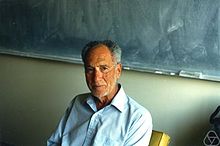Gerhard Hochschild
Gerhard Paul Hochschild (born April 29, 1915 in Berlin , † July 8, 2010 in El Cerrito , California ) was an American mathematician who studied algebra .
Hochschild came from a Jewish family, attended high school in Berlin and was sent to safety in Cape Town by his father, a patent attorney, with his brother in 1933 when the Nazis came to power . There he was forced to earn a living as a photographer's assistant (photography later remained his hobby). From 1934 he studied mathematics at the University of Cape Town with a bachelor's degree in physics and mathematics in 1936 and a master's degree in mathematics in 1937. He was in 1941 at Princeton University , where he studied since 1938 with a recommendation from his teacher in South Africa Stanley Skewes , with Claude Chevalley is doing her PhD ( Semisimple Algebras and Generalized Derivations ). He was Chevalley's PhD student at Princeton, who also gave him insight into early Bourbaki manuscripts. At that time he also took over a passion for the game of Go from Chevalley. His teachers at Princeton included Chevalley Luther P. Eisenhart , John von Neumann , Salomon Bochner and Paul Halmos . After his doctorate, he served in the US Army as a mathematician calculating ballistic tables in the Aberdeen Proving Ground under Oswald Veblen . After the war he was first an instructor at Princeton, from 1946 to 1948 Benjamin Peirce instructor at Harvard University and from 1948 assistant professor and from 1952 professor at the University of Illinois at Urbana-Champaign . In 1951/52 he was visiting professor at Yale University , 1955/56 at the University of California, Berkeley , and in 1956/7 he was at the Institute for Advanced Study . From 1951 to 1954 he attended the Bourbaki Congresses as a visitor. From 1958 he was a professor at the University of Berkeley , where he retired in 1982, but held lectures until 1985.
Hochschild worked on Lie groups , algebraic groups, and homological algebra . The concept of Hochschild homology named after him defines a homology for algebras. There is also a Hochschild cohomology that classifies the deformation of algebras.
He introduced cohomology into class field theory (after he had previously applied cohomological methods in the theory of Lie groups), first into local theory and in 1952 Tadashi Nakayama into global theory, which was then expanded in the well-known Artin - Tate seminar at Princeton.
The Hochschild-Kostant-Rosenberg (HKR) theorem, which proposed a connection between the Hochschild homology of an algebra and differential forms, later played a large role in the non-commutative geometry of Alain Connes .
His PhD students include Andrzej Bialynicki-Birula, James Ax .
In 1955 he was a Guggenheim Fellow . In 1980 he received the Leroy P. Steele Prize from the American Mathematical Society . From 1979 on he was a member of the National Academy of Sciences and he was a member of the American Academy of Arts and Sciences .
He had been married to the mathematician Ruth Heinsheimer (a student of Reinhold Baer ), who died in 2005, since 1950 , with whom he had a son and a daughter.
Fonts
- The structure of Lie groups , Holden-Day, San Francisco 1965
- Introduction to affine algebraic groups , Holden-Day, San Francisco 1971
- Basic theory of algebraic groups and Lie algebras. Springer, Graduate Texts in Mathematics, 1981.
- Perspectives of elementary mathematics. Springer 1983.
- A second introduction to analytic geometry , Holden-Day 1968
Web links
- Gerhard Hochschild in the Mathematics Genealogy Project (English)
- Page at the University of Berkeley
- Gerhard Hochschild (1915-2010)
- Walter Ferrer Santos, Martin Moskowitz Gerhard Hochschild (1915-2010) , Notices of the American Mathematical Society, Volume 58, No. 8, 2011, pdf
- Obituary by Walter Ferrer Santos, Arxiv 2011
Individual evidence
- ↑ On. J. Math., Vol. 64, 1942, pp. 677-694
- ^ Hochschild On the cohomology groups of an associative algebra , Annals of Mathematics, Series 2, Volume 46, 1945, pp. 58/67
- ^ Hochschild, Nakayama Cohomology in class field theory , Annals of Mathematics, Series 2, Volume 55, 1952, pp. 348-366
- ^ Hochschild, Bertram Kostant , A. Rosenberg Differential forms on regular affine algebras , Trans. American Mathematical Society, Volume 102, 1962, pp. 383-408
| personal data | |
|---|---|
| SURNAME | Hochschild, Gerhard |
| ALTERNATIVE NAMES | Hochschild, Gerhard Paul (full name) |
| BRIEF DESCRIPTION | American mathematician |
| DATE OF BIRTH | April 29, 1915 |
| PLACE OF BIRTH | Berlin |
| DATE OF DEATH | July 8, 2010 |
| Place of death | El Cerrito , California |
